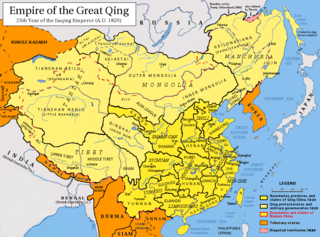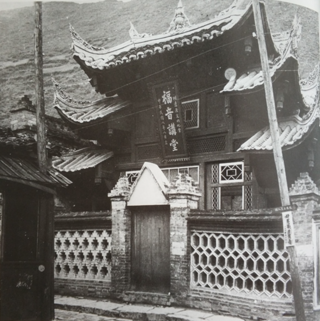Related Research Articles

Sichuan is a province in Southwestern China occupying the Sichuan Basin and Tibetan Plateau between the Jinsha River on the west, the Daba Mountains in the north and the Yungui Plateau to the south. Sichuan's capital city is Chengdu; its population stands at 83 million. Sichuan neighbors Qinghai to the northwest, Gansu to the north, Shaanxi to the northeast, Chongqing to the east, Guizhou to the southeast, Yunnan to the south, and Tibet to the west.

The Tarim Basin is an endorheic basin in Xinjiang, Northwestern China occupying an area of about 888,000 km2 (343,000 sq mi) and one of the largest basins in Northwest China. Located in China's Xinjiang region, it is sometimes used synonymously to refer to the southern half of the province, that is, Southern Xinjiang or Nanjiang, as opposed to the northern half of the province known as Dzungaria or Beijiang. Its northern boundary is the Tian Shan mountain range and its southern boundary is the Kunlun Mountains on the edge of the Tibetan Plateau. The Taklamakan Desert dominates much of the basin. The historical Uyghur name for the Tarim Basin is Altishahr, which means 'six cities' in Uyghur. The region was also called Little Bukhara or Little Bukharia.

Mianyang is the second largest prefecture-level city of Sichuan province in Southwestern China. Located in north-central Sichuan covering an area of 20,281 square kilometres (7,831 sq mi) consisting of Jiangyou, a county-level city, five counties, and three urban districts. Its total population was 4,868,243 people at the 2020 Chinese census, of whom 2,232,865 live in its built-up area made of three urban districts.

The Tea Horse Road or Chamadao, now generally referred to as the Ancient Tea Horse Road or Chamagudao was a network of caravan paths winding through the mountains of Sichuan, Yunnan and Tibet in Southwest China. This was also a tea trade route. It is also sometimes referred to as the "Southern Silk Road" or "Southwest Silk Road."

Tri Songdetsen was the son of Me Agtsom, the 38th emperor of Tibet. He ruled from AD 755 until 797 or 804. Tri Songdetsen was the second of the Three Dharma Kings of Tibet, playing a pivotal role in the introduction of Buddhism to Tibet and the establishment of the Nyingma or "Ancient" school of Tibetan Buddhism.

Sichuanese, Szechwanese or Szuchuanese (simplified Chinese: 四川话; traditional Chinese: 四川話; Sichuanese Pinyin: Si4cuan1hua4; pinyin: Sìchuānhuà; Wade–Giles: Szŭ4-ch'uan1-hua4), also called Sichuanese/Szechwanese/Szuchuanese Mandarin (simplified Chinese: 四川官话; traditional Chinese: 四川官話; pinyin: Sìchuān Guānhuà), is a branch of Southwestern Mandarin spoken mainly in Sichuan and Chongqing, which was part of Sichuan Province until 1997, and the adjacent regions of their neighboring provinces, such as Hubei, Guizhou, Yunnan, Hunan and Shaanxi. Although "Sichuanese" is often synonymous with the Chengdu-Chongqing dialect, there is still a great amount of diversity among the Sichuanese dialects, some of which are mutually unintelligible with each other. In addition, because Sichuanese is the lingua franca in Sichuan, Chongqing and part of Tibet, it is also used by many Tibetan, Yi, Qiang and other ethnic minority groups as a second language.

Tsering Woeser is a Tibetan writer, activist, blogger, poet and essayist.

Xinjiang is historically consisted of two main geographically, historically, and ethnically distinct regions with different historical names: Dzungaria north of the Tianshan Mountains; and the Tarim Basin south of the Tianshan Mountains, currently mainly inhabited by the Uyghurs. They were conquered by the Qing dynasty in the 18th century, and after the Dungan Revolt (1862–1877) the Qing reconquered both regions and integrated them into one province named Xinjiang in 1884.

Princess Wencheng was a princess and member of a minor branch of the royal clan of the Tang dynasty, who married King Songtsen Gampo of the Tibetan Empire in 641. She is also known by the name Gyasa or "Chinese wife" in Tibet. Both Wencheng and Songtsen Gampo's first wife, Nepali princess Bhrikuti, are considered to be physical manifestations of the bodhisattvas White Tara and Green Tara respectively.

Alan Dawa Dolma, known mononymously as alan, is a Tibetan singer from China. She is a graduate of the People's Liberation Army (PLA) Academy of Art in Beijing, majoring in vocal music and erhu, which she has played since childhood. Alan is known for a distinctive technique called the "Tibetan wail".

The Tibetan Empire was an empire centered on the Tibetan Plateau, formed as a result of imperial expansion under the Yarlung dynasty heralded by its 33rd king, Songtsen Gampo, in the 7th century. The empire further expanded under the 38th king, Trisong Detsen, and expanded to its greatest extent under the 41st king, Rapalchen, whose 821–823 treaty was concluded between the Tibetan Empire and the Tang dynasty. This treaty, carved into the Jokhang Pillar, delineated Tibet as being in possession of an area larger than the Tibetan Plateau, stretching east to Chang'an, west beyond modern Afghanistan.

During Tang dynasty rule in China (618–907), a complex relationship between imperial China and Tibet regime was developed. During this period Chinese and Tibetan forces had many battles since both parties were military powers, but there were also years of peace and friendly relations.

Tan Weiwei, also known as Sitar Tan, is a Chinese singer and actress.

Christianity is a minority religion in the southwestern Chinese province of Sichuan. The Eastern Lipo, Kadu people and A-Hmao are ethnic groups present in the province.

The Qing dynasty in Inner Asia was the expansion of the Qing dynasty's realm in Inner Asia in the 17th and the 18th century AD, including both Inner Mongolia and Outer Mongolia, both Manchuria and Outer Manchuria, Tibet, Qinghai and Xinjiang.

Nenghai was a Vajrayana Buddhist monk of the Gelug school and religious leader in modern China. He is considered one of the key figures of the "Movement of Tantric Rebirth" (密教復興運動) which sought to revitalize Chinese Esoteric Buddhism.
Choenyi Tsering is a Chinese actress and singer of Tibetan descent. Choenyi Tsering was best known for her roles as Princess Aliya on Love Yunge from the Desert (2013) and Zhang Lihua/ Zhu Gui'er on Heroes in Sui and Tang Dynasties (2013) and also starred in a number of films, including Zhanian Instrument (1999), Women Who Know How to Flirt Are the Luckiest (2013), Zhong Kui: Snow Girl and the Dark Crystal (2014), and Soul on a String (2017).

Sichuan embroidery or Shu embroidery, is a style of embroidery folk art native to Sichuan and Chongqing, particularly renowned for its brocade fabrics known as Shu brocade. This technique of embroidery originates from Chengdu, the capital of Sichuan, during the time of the Ancient Kingdom of Shu. An excavation of four tombs dating back to the Western Han dynasty, on Mount Laoguan located in Tianhui Town, Chengdu, has confirmed the use of patterning looms for weaving warp-faced compounds in that period.

Gospel Church, today known as Kangding Christian Church, is a Protestant church situated on Guangming Road, Kangding, a county-level city in Garzê Tibetan Prefecture, Sichuan Province. First built in 1905, on Yanhe West Road, by China Inland Mission missionaries, the church was relocated to its present location in 1958. It has been subjected to the control of the state-sanctioned Three-Self Patriotic Church since 1954.
The history of Adventism in Sichuan began in 1914 when American and Chinese missionaries arrived in Chongqing. Adventist missionaries in Sichuan were organized under the Szechwan Mission, later split into the East Szechwan, West Szechwan, and Tibetan Missions. Missionary activity in China generated controversy among many native Chinese and faced opposition from popular riots and the later Communist movement in China. Numerous mission properties and native Church leaders in Sichuan were respectively destroyed and killed by communists in the mid-1930s. Missionary activity ceased after the communist take over of China in 1949. Under government oppression in the 1950s, Adventist congregations and other Protestant Churches across China severed their ties with overseas Churches, and their congregations subsequently merged into the Three-Self Patriotic Church. Since 1980, their services have been provided by the China Christian Council.
References
- ↑ Rudolph, Josh (9 March 2017). "Person of the Week: Tang Danhong". China Digital Times (CDT). Retrieved 18 February 2023.
- 1 2 Hu Xiao (Chinese :胡晓) (5 March 2008). "消失9年 "卡夫卡"女诗人唐丹(组图)" ['Kafka' poetess Tang Dan disappeared for 9 years]. Sohu (in Chinese).
{{cite web}}: CS1 maint: multiple names: authors list (link) - ↑ Tang Danhong (October 2012). X光的、甜蜜的夜[X-ray, Sweet Night] (in Chinese). 出版社黑蓝文学. ISBN 978-7-6570-6365-7.
- ↑ Tang Danhong (21 March 2008). "Tibet: Her Pain, My Shame". China Digital Times .
- ↑ Beach, Sophie (30 June 2016). "Troubled Times: Voices of Tibetan Refugees". China Digital Times .
- ↑ Tang Danhong (18 February 2019). "塔里木,一个维吾尔人" [Tarim, A Uyghur]. China Digital Times (in Chinese).
- ↑ Rudolph, Josh (13 March 2019). "Three Poems by Detained Uyghur Poet 'Tarim'". China Digital Times .
- ↑ Hu, Lidan (28 March 2018). "A brief history of women's filmmaking". Modern Chinese Literature and Culture, Ohio State University.
- ↑ Chu, Yingchi (2007). Chinese Documentaries: From Dogma to Polyphony. Routledge. p. 247. ISBN 978-1-134-18603-7.
- ↑ Qiang, Xiao (23 March 2008). "Tibet: Her Pain, My Shame". China Digital Times (CDT). Retrieved 18 February 2023.